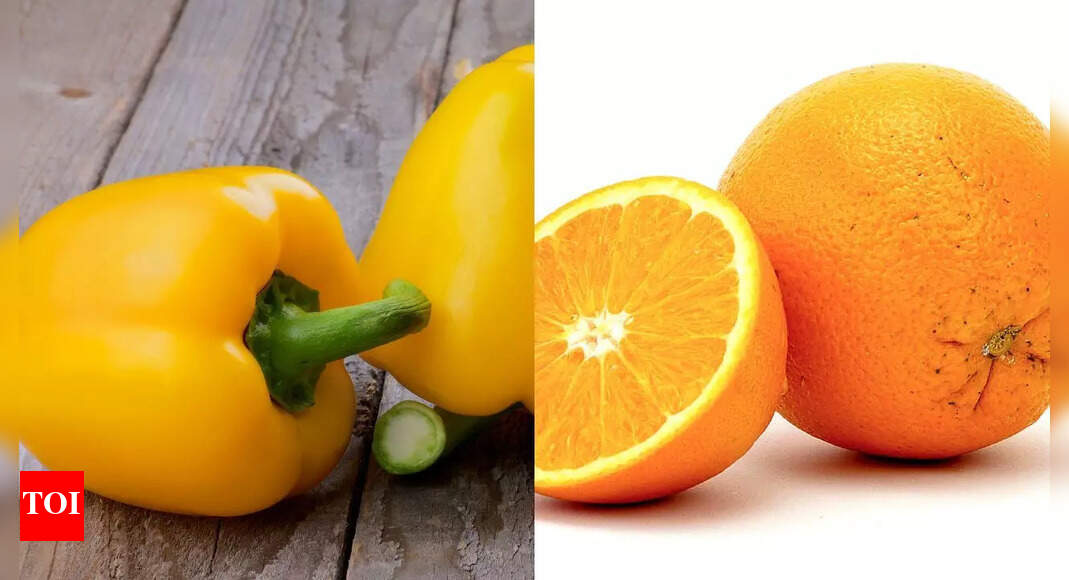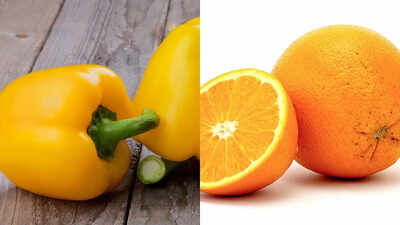
When we think of vitamin C, oranges are usually the first thing that comes to mind. However, there’s a colourful contender that quietly outshines this citrus favourite, the yellow bell pepper. Packed with vibrant colour and impressive nutrition, yellow bell peppers contain even more vitamin C per 100 grams than oranges, making them a powerful ally for your immune system, skin health, and overall vitality. Beyond their bright appeal, these sweet peppers are a true nutritional treasure, offering a combination of antioxidants, fibre, and essential minerals that go far beyond the benefits of citrus fruits, while also supporting collagen production, boosting energy levels, and promoting better iron absorption in the body.
Why yellow bell peppers beat oranges in Vitamin C content
While both orange and yellow bell peppers are excellent sources of vitamin C, the yellow variety comes out on top when it comes to nutrient concentration. A study published in the Journal of Alchemy found that yellow bell peppers contain an average of 159.61 mg of vitamin C per 100 grams, compared to 121.38 mg in orange peppers. This means that yellow capsicum provides around 30% more vitamin C than its orange counterpart.
The difference lies in the ripening stage and pigment composition. As bell peppers mature from green to yellow to orange and finally red, their nutrient profile evolves. The yellow stage marks a point of peak vitamin C and antioxidant content, before some of these nutrients slightly reduce as the pepper turns red and becomes sweeter.Therefore, if you’re looking to maximise your vitamin C intake, especially for immune support, skin repair, and collagen production, the yellow bell pepper is your best pick. However, both orange and yellow varieties are far superior to green peppers when it comes to overall antioxidant and vitamin content, making them vibrant, heart-healthy additions to any diet.
How yellow bell peppers boost your health
1. Strengthens immunityWith their exceptionally high vitamin C content, yellow bell peppers enhance immune defence by stimulating the production of white blood cells and antibodies. Regular consumption can help reduce the severity and duration of common colds and infections.2. Promotes healthy, glowing skinVitamin C is a vital component in the production of collagen, which keeps skin firm, youthful, and elastic. Combined with the antioxidants and carotenoids found in yellow peppers, it helps combat oxidative stress, promoting a natural glow and preventing premature ageing.3. Improves heart healthThe antioxidants in yellow bell peppers, such as lutein, zeaxanthin, and beta-carotene, work alongside vitamin C to protect blood vessels from oxidative damage. This combination helps lower inflammation, support healthy cholesterol levels, and improve overall cardiovascular function.4. Aids iron absorptionPlant-based iron sources (from lentils, spinach, or beans) are not as easily absorbed by the body as animal-based iron. Vitamin C enhances iron absorption from plant foods, making yellow bell peppers a perfect pairing with vegetarian or vegan meals.5. Supports eye healthYellow bell peppers are rich in lutein and zeaxanthin, two carotenoids that protect the retina from light-induced damage and may lower the risk of age-related macular degeneration — a leading cause of vision loss in older adults.Vitamin C, also known as ascorbic acid, plays a crucial role in multiple aspects of human health. It supports the immune system, helps the body absorb iron from plant-based foods, and is vital for collagen production, the protein responsible for maintaining healthy skin, joints, and connective tissues.Additionally, vitamin C acts as a powerful antioxidant, helping to neutralise free radicals that can damage cells and accelerate ageing. Regular intake can reduce the risk of chronic diseases such as heart disease and certain cancers, while also supporting faster wound healing and healthier gums.While oranges contain more natural sugars and fibre, yellow bell peppers deliver nearly three times more vitamin C with fewer calories and less sugar, making them an excellent choice for those managing blood sugar levels or looking to boost nutrient intake without added calories.
Best ways to enjoy yellow bell peppers
Yellow bell peppers are deliciously sweet and versatile. To retain their vitamin C content, which is heat-sensitive, it’s best to consume them raw or lightly cooked. Here are a few ways to add them to your diet:
- Raw in salads: Slice into strips and toss with leafy greens, cucumber, and lemon dressing.
- Grilled or roasted: Add depth and sweetness to your meals without losing too many nutrients.
- Stuffed: Fill with quinoa, beans, and herbs for a nutrient-packed lunch.
- Juiced or blended: Combine with oranges, carrots, and ginger for a vitamin-rich smoothie.
- As a snack: Pair raw pepper slices with hummus or Greek yoghurt dip for a quick, healthy bite.
Why bell pepper colour matters for nutrition
The colour of bell peppers isn’t just for show; it reflects their ripeness and nutrient content. Green peppers are unripe and contain the least vitamin C, while yellow and orange ones are more mature and nutrient-dense. The deep yellow colour indicates a higher concentration of carotenoids and antioxidants, making them not just visually appealing but also nutritionally superior.Disclaimer: This article is for informational purposes only and should not be considered medical advice. Please consult a healthcare professional before making any changes to your diet, medication, or lifestyle.Also read | 7 dry fruits people with diabetes should avoid to control blood sugar








